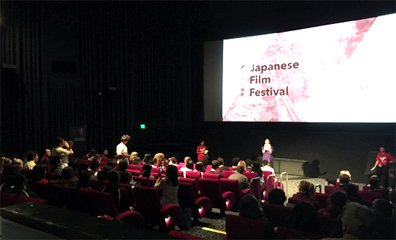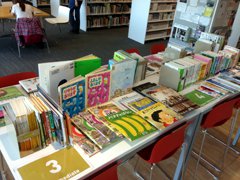A Fun Learning Place Outside the Classroom
The Japan Foundation, Sydney
SAITO Mami, SUMA Ayuko, and HIRAKAWA Shunsuke
Gather Round, Secondary and Senior Secondary School Students! Together on an Emotional Rollercoaster
Have you ever used a movie to learn a language?
Movies are filled with culture from a country or land, such as people's behavior, the scenery in the background, and, of course, the language, and movies are indispensable resources for language learning.
The Japan Foundation holds Japanese film festivals around the world, and here in Australia the Japanese Film Festival is attracting a great deal of attention as a major event for film directors and famous actors/actresses to visit Australia. Furthermore, as a collaboration event with the Japanese Film Festival, we, the Japanese-Language Education Team, are holding a "School Screening" event that brings together secondary and senior secondary school students who are learning the Japanese language. This is our report on the event.

Is Pikachu modeled on Australian animals? Yes or No?
For the FY2018 School Screening, there were 3,321 people that participated, from 113 schools across all of the states of Australia, but what is the attraction of the event?
You might be thinking that "Nowadays it's easy to watch movies in the classroom," or "Why not go to a movie theatre as a class trip without an event?" However, the fact that students from so many schools meet together and watch the same movie gives rise to a charm and appeal that can never be felt in a classroom. Approximately 140,000 secondary and senior secondary school students in Australia are learning the Japanese language, but there are few opportunities for them to interact with students from other schools on the common ground of "studying the Japanese language." However, when they entered the movie theatre at the School Screening event and saw that the large venue was filled with senior secondary school students learning the Japanese language, they were able to experience the fact that there are many nearby friends who are also learning the Japanese language. Furthermore, so as to make the experience even better for the people who had gathered here, we also had a mini quiz tournament before the movie. In addition to questions about basic information on Japan, the quiz includes questions about the relationship between Japan and Australia, such as "Is Pikachu modeled on Australian animals? Yes or No?" so that they can recognize the connection between themselves and Japan. It's always very exciting because the schools are competing against each other. However, the most exciting part of the day is the teachers' quiz competition after the students' quiz competition. In a rarely viewed scene, the venue is filled with a fun atmosphere and everyone is cheering on the teachers who are "ganbatteiru (working hard)." During the screening as well, the atmosphere in the venue went up and down with the mood of the main character. Last year we screened "My Love Story!!" which is an emotional roller coaster wherein the main character's love story, despite being promising, doesn't seem to work out. The laughter and sighs of relief echoed throughout the movie theatre and created a sense of unity amongst everyone, as if they were watching together at home on a big TV.
As Japanese-Language Specialists who are dispatched, our primary duties are to attend a Japanese-language teacher training program in various regions and to create teaching material resources for teachers, so we do not have many opportunities to actually interact with students on a daily basis. As such, the School Screening is a special time for us to see the moment when the students, who are outside of and beyond the teacher training, come into contact with Japan and the Japanese language.
Tadoku Reading Recommendations -- Having Fun Reading Lots of Books!
Our other report is about a library event, and we will introduce the "Tadoku Reading Nights" that are held by the library at The Japan Foundation, Sydney (hereinafter the “Center”), which are widely used by Japanese-language learners and by Japanese people living in Australia.
Have you ever heard the word "Tadoku (extensive) reading"? This is one of the ways to learn the Japanese language, and it is fun to read lots of Japanese books and learn the Japanese language. This is a method that is different from reading a difficult book cover to cover while looking things up in a dictionary. Instead, Tadoku reading is a method in which you start by reading books at an easy level, skipping words that you don't understand, and you read a lot of books that you want to read. The library at the Center holds Tadoku Reading Nights twice a month.
The important thing with Tadoku reading is to have fun while reading. You don't have to understand all of the words, and, if you think that a book isn't very interesting, just pick up another book that does look interesting. By looking at the pictures and photos, by guessing the meaning of words that appear many times, and by taking in a lot of the Japanese language, you will absorb the Japanese language. At the Center, after about 60 to 90 minutes of Tadoku reading, there is also time for a group of several people to reflect on their impressions of a book. They share not only their impressions of the book, but also what kind of words were difficult, what was interesting, and what they noticed. Talking about books is also a place for interaction and dialogue, which is one of the great attractions of the Tadoku Reading Nights. Please see this link for more information on the Tadoku Reading Nights.
Tadoku reading began at the Center in 2014 as a library event, and it is now held twice a month as a regular event. The Tadoku Reading Nights have been incorporated into a Japanese-language teacher training program at the Center and into Center Visits (student programs), and are very popular. Japanese-Language Specialists are responsible for orientations at Tadoku Reading Nights and participate together in each evening's final reflections on the books. Together with librarians, they also assign levels to books for Tadoku reading.
There are Tadoku reading books with certain levels of vocabulary and grammar, but there is a limit to these, so we also check the content of and assign levels to picture books, comic essays, and other books for primary school students. The Tadoku reading books are selected with an awareness of being fun to read and being able to experience the Japanese language, which is different from reading a textbook. It takes some time and effort to maintain these reading materials as a collection with assigned levels, but it is very useful for Tadoku reading participants, general Japanese-language learners, and library users to be able to easily select their favorite topics at an appropriate level. Unlike libraries in other regions, this is an event that can only be done by the Japan Foundation's library, which has a large selection of Japanese books.

A variety of materials for Tadoku reading
- What We Do Top
- Arts and Cultural Exchange [Culture]
- Japanese-Language Education Overseas [Language]
- Japanese-Language Education Overseas [Language] Top
- Learn Japanese-language
- Teach Japanese-language
- Take Japanese-Language Test
- Know about Japanese-language education abroad
- The Japanese-Language Institute, Urawa
- The Japanese-Language Institute, Kansai
- Japanese-Language Programs for Foreign Specified Skilled Worker Candidates
- Japanese Language Education for Japanese Children Resident Overseas and for the Descendants of Migrants
- Archives
- Japanese Studies and Global Partnerships [Dialogue]
- JF digital collection
- Other Programs / Programs to Commemorate Exchange Year
- Awards and Prizes
- Publications
